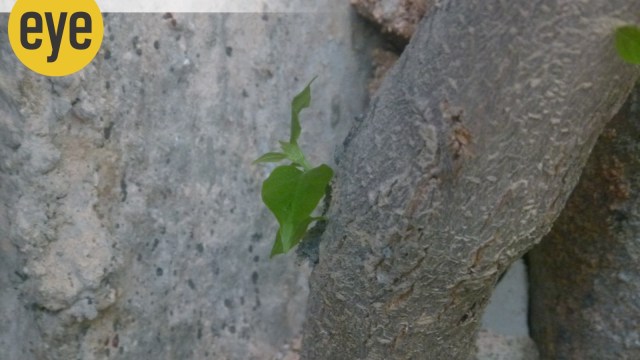The promise of life – how seeds can find their way through rubble
The rose plants were sticking new leaves out of the stumps and a solitary straggling pink bloom was defiantly sticking its head out. Talk about surviving Armageddon
 The defiant bougainvillea sprouts again (Photo credit: Ranjit Lal)
The defiant bougainvillea sprouts again (Photo credit: Ranjit Lal)For the last four months, my garden has resembled a war zone. The two balconies overlooking it had to be demolished and rebuilt, which meant it was for several months, completely buried under rubble, building material and cement mixture. I watched with horror as the grass, shrubs, and small plants just disappeared under the carnage: granted I don’t have the greenest of thumbs but there were shrubs and plants that had thrived here. There was the spindly curry patta tree that despite our grave misgivings and doubtful prognosis, had somehow taken root, there were a series of desi rose plants that delighted every winter with lovely pink blooms, there was a fragile mosambi tree struggling to find its feet, there was a mango tree that was leafy enough to give us hope that it would fruit in the coming year… Along the beds, there were different vegetables growing at different times – palak, chillies, aubergine, tulsi and tomato, which had to be guarded against the depredations of monkeys and peafowl.
All of this went under during the bombardment and mountains of malba dumped over them. On the other side of the house was a venerable 40 year-old bougainvillea that had provided a home for generations of red-whiskered bulbuls, accommodated (at one time) a humming beehive and provided a happy hunting ground for solemn white-eyes, and cheerful tailorbirds, et al. This too had to be mercilessly hacked as the balconies above ours were demolished and rebuilt, and it was in the way.
Apart from not being able to access the garden for the last four months, it was depressing to even gaze at it. I wondered if it could ever be rehabilitated. It also made me realise how much of a mood lifter even a small patch of green could be. I never took the success or (more often) the failure of any plant or shrub to heart: if it did well, great, if not – well, well never mind, we’ll try again, perhaps with something different this time. (But I did wage a relentless war against the monkeys and peafowl that invaded it every so often). Nor did I get into the intricacies of gardening; into soil mixes and composting and stuff like that: I left that to the gardener and just suggested that it would perhaps be nice if we could try some Shimla mirch or sunflowers or celery… (The celery was a huge hit; I was neck-deep in celery soup for a couple of years). Bananas, too, had done very well some years ago – except that about 25 kg of them would all ripen and be perfect to eat on the same day, and there’s no way you can get through that even if you did make banana bread or banana chips. You’d be sick of them soon enough. Well, that taught you to be generous – because you had to give most away or watch them blacken and go gluey and attract flies.
But it was different now when suddenly I found that my whole garden was basically a disaster area. Dispiritedly I looked at the mutilated stumps of the bougainvillea outside my bedroom window and then my eyes widened. Thrusting out defiantly from the ugly amputated stumps were tiny, shiny new bronze leaves, a few beginning to turn green. And peeping out from behind the water pipe that ran down the wall beside it, were more, swaying in the gentle breeze, as if waving and saying, ‘Hey there, we’re still here! Don’t write us off just yet.’
And when I managed to step into the garden again, after some of the rubble had been removed, I got another pleasant surprise. The rose plants were sticking new leaves out of the stumps that had somehow survived – and these saplings had completely disappeared from view under the rubble. And just this morning, there was a solitary straggling pink bloom defiantly sticking its head out. Talk about surviving Armageddon. Not only that, the spindly curry patta tree still rose defiantly out of the choking muck heaped around it as did the fragile mosmabi tree. They look kind of marooned, because all the small companion shrubs surrounding them had been buried. The mango tree, which had not been in the direct line of fire, seems to have prospered. I can only hope that they will not, like so many shell-shocked soldiers, now suffer from Post-Traumatic Stress Disorders and need counselling.
But seeds as we know, can survive for years without sustenance and come to life with the first drops of water they may receive. Botanical institutions and NGOs around the world (for example at the Kew Gardens in London and at home the Beej Bachao Andolan) have stored millions of seeds of especially crop plants just so they could be planted if and when we lay waste to planet Earth, which we seem so impatient to do. So what’s a bit of rubble in a garden? Any seed buried under it will surely – once stability returns – thrust itself up back into the sunlight – upwards and onwards, with its war cry: ‘zinda dil’!
Think of the bigger picture: If life on planet Earth could survive the violent volcanic explosions of Toba and Krakatoa and the meteor that smashed into the Earth and killed off the dinosaurs 66 million years ago, then anything is possible. Out of the ruins, willy-nilly, life will return. So, hopefully, will my garden!
- 01
- 02
- 03
- 04
- 05






























